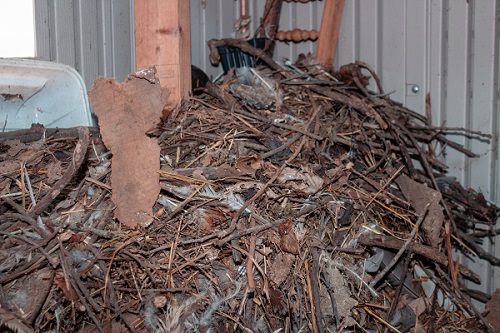Rats are some of the most common and most destructive pests that could infest your house. 12% of households have seen rats or mice in their house. Homeowners in these cities might experience more rats than the national average:
Trutech’s Rattiest Cities
- Greenville-Spartanburg
- Kansas City
- Minneapolis
- Seattle
- Tampa-St. Petersburg
Rat Damage and Diseases
Rats almost seem designed to antagonize humans—they are known to transmit more than 35 diseases, breed at a staggering rate, and commonly invade homes, set up nests, and pillage pantries. The most common rat species that damage your house are Norway rats and roof rats.
Read on to discover how they cause damage to homes, and, more importantly, how they can be deterred.
Structural Damage Caused by Rats
Like all rodents, rats’ incisors continuously grow so they must regularly gnaw to manage the growth. In fact, homeowners can hear their constant gnawing. Rats will gnaw on any material in your home. It becomes a serious issue when rats gnaw on electrical wires. Frayed electrical wires can significantly increase of house fires.
Not only will they gnaw through wood and other materials out of necessity to keep their teeth from getting too long, but they also gnaw to gather nesting materials.
Dangers of Rat Nests
Once rodents have entered your house and located sources of food and water, they will start building a nest. Rats use anything they can to build a nest—paper, clothes, insulation, you name it. Rats might even start chewing drywall and wiring in their efforts to build a nest; this can cause significant damage to your home and even increase the likelihood of a house fire.

The nest may resemble a messy ball-shaped structure or a heap of various materials. A rat nest typically consists of a collection of materials loosely piled up in a hidden location. These materials can include shredded paper, fabric, insulation, leaves, twigs, and other debris found in their surrounding.
Homeowners find rat nests in enclosed areas like crawlspaces, between walls, in attics, under porches, or in boxed-in plumbing.
If you find a rat nest, do not disturb it. Rats can become aggressive to protect the nest. Removing a nest won’t drive the rats out; they are likely to build a new one. Finally, rat nests will be contaminated by rat droppings and rat urine.
Contamination and Rat Diseases
Shortly after a rat enters a home, it will embark on a search for food. As they roam about in search of food, they spread urine and feces throughout the house. Rats travel the same path repeatedly and will use their droppings and urine to mark a safe path.
If a rat reaches your pantry, it will easily be able to access food products by tearing through packaging with its sharp teeth. This is a concern because contact with rat feces, urine, or saliva can result in the transmission of a whole host of diseases, including salmonellosis, Lassa Fever, Leptospirosis, Rat-bite Fever, and Tularemia, to name just a few. In fact, a rat infestation can threaten public health.
Rats are also known to carry ectoparasites (such as fleas or ticks), which carry diseases of their own. In short, having rats in your house isn’t just a nuisance; it’s a legitimate health risk. Check our guide to getting rid of rodents here.
Professional Rat Control
Rats and mice are the ultimate pests: they do destructive damage and spread disease while breeding at an alarming rate. If you have a rat infestation, the signs of rats include damage, rat droppings, gnawing sounds and gnaw marks, and grease marks.
It goes without saying that exterminating rats and mice is a formidable task, one that might require pest control professionals. Give our team of experts at Trutech a call as soon as a rat or mouse problem becomes apparent, as infestations can set in in the blink of an eye.


